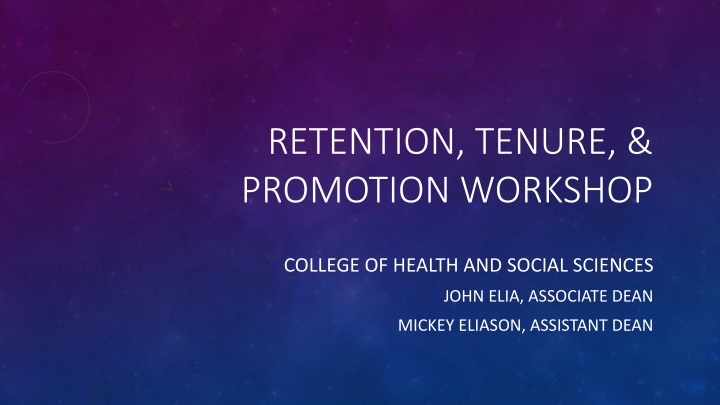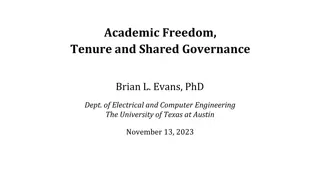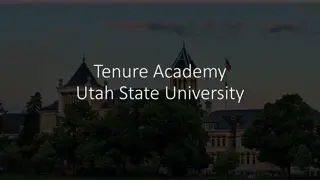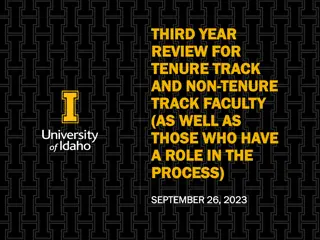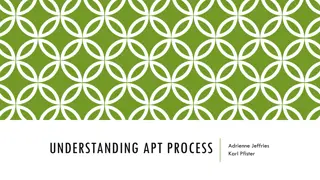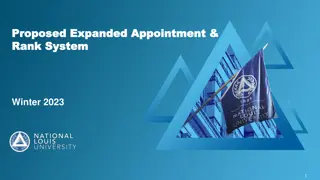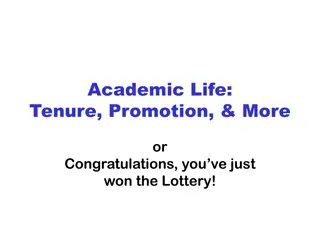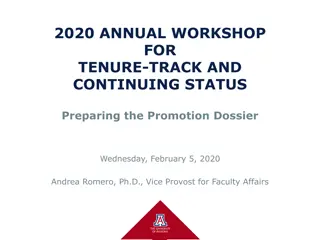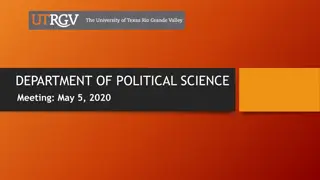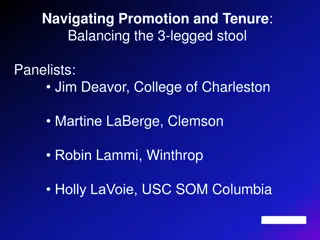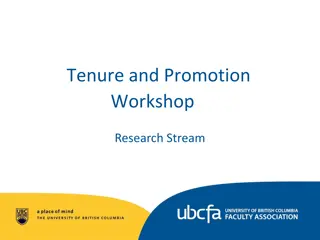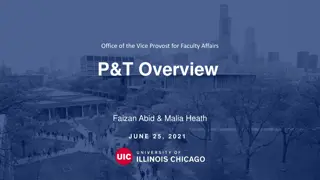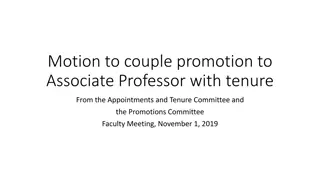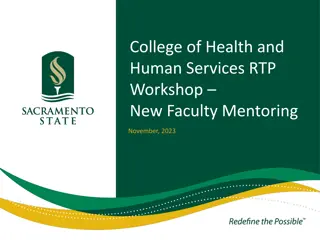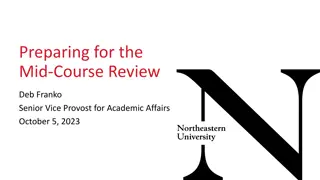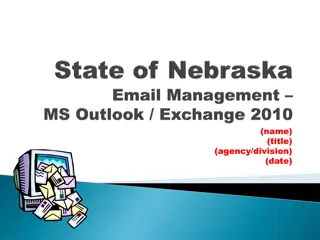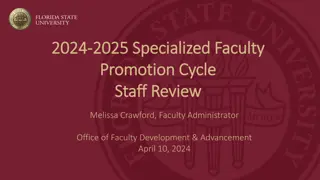Faculty Retention, Tenure, and Promotion Workshop Guidelines
Explore essential insights on faculty retention, tenure, and promotion processes discussed in the workshop by the College of Health and Social Sciences. Learn about dossier preparation, levels of review, CV guidelines, and key considerations to enhance your candidacy for RTP.
Download Presentation

Please find below an Image/Link to download the presentation.
The content on the website is provided AS IS for your information and personal use only. It may not be sold, licensed, or shared on other websites without obtaining consent from the author.If you encounter any issues during the download, it is possible that the publisher has removed the file from their server.
You are allowed to download the files provided on this website for personal or commercial use, subject to the condition that they are used lawfully. All files are the property of their respective owners.
The content on the website is provided AS IS for your information and personal use only. It may not be sold, licensed, or shared on other websites without obtaining consent from the author.
E N D
Presentation Transcript
RETENTION, TENURE, & PROMOTION WORKSHOP COLLEGE OF HEALTH AND SOCIAL SCIENCES JOHN ELIA, ASSOCIATE DEAN MICKEY ELIASON, ASSISTANT DEAN
AGENDA AND OBJECTIVES Introductions: Audience = candidates for RTP and people who write the letters (departmental RTP chairs, chairs) Share insights from college and university-level review processes Share tips for organizing files and presenting data Discuss best practices for narratives All material in this slide set is explained in more detail in the CHSS RTP Manual
SOME BASIC INFO RTP is an ongoing activity of faculty, not discrete events The dossier for RTP at SF State is called the Working Personnel Action File (WPAF) All materials are now posted on a system called Interfolio and there is a learning curve for using it Faculty Affairs also hosts yearly RTP workshops and has good information on their website Each level of review is charged with reviewing the material in your file and does not take into consideration any outside information. Make sure your file is complete and comprehensive.
LEVELS OF REVIEW 1. your department RTP committee 2. your department chair 3. the Dean of the college 4. Faculty Affairs, the Provost level 5. The University Tenure and Promotion Committee (UTPC) simultaneous with provost review 6. The President of the university After you receive the letter at each level, you have 10 days to file a rebuttal to the Interfolio site if you think the report is in error.
THE CURRICULUM VITAE Make sure it is up-to-date and that all titles of articles, books, other materials listed in the CV are the same as the documents included in the file. Use the Faculty Affairs template for the CV (reverse chronological order for all work) Some faculty put tables about teaching effectiveness in the CV, others prefer to have the information elsewhere.
THE CV The CV may list articles and books that are under review, but these manuscripts are not to be included in the file. If a manuscript is accepted after the deadline for closing the file has passed, you can petition to add it later. Separate out different kinds of publications: peer-reviewed, editor-reviewed, invited works, creative works, journal articles, book chapters, etc Highlight the accomplishments of the current review period
NARRATIVES: GENERAL COMMENTS Put all three narratives in one document (there is a separate place for the narrative in Interfolio). Each of the 3 sections of the narrative is limited to 750 words, but you can use the words somewhat flexibly. An intro paragraph Then 3 sections (Teaching, Scholarship, Service) A summary statement of your future plans and/or links between the areas Use narratives to explain your materials and link themes.
NARRATIVES Be evaluative and show the impact of your work rather than describe what you did; make a case for the quality of your work and how it adds to your discipline. After the file leaves your department, reviewers will probably not be familiar with your field, so avoid jargon and technical language. Address how you meet your departmental criteria in each area.
TEACHING EFFECTIVENESS SETE evaluations for all of the classes under the review period Summary documents about teaching effectiveness: charts, tables, graphs of your SETEs by semester or by individual courses, organization of qualitative comments, etc. Peer observations of teaching Syllabi (one per course if you teach the same class repeatedly usually the most recent one) Innovations in teaching: sample assignments or activities, novel aspects of your teaching (optional)
EXAMPLES OF WAYS TO PRESENT SETE OVERALL SCORES: BY SEMESTER AND COURSE Candidate Dept 2.5 2.13 2.11 2.11 2 1.98 1.97 1.88 1.87 1.87 1.87 1.82 1.79 1.77 1.76 1.68 1.75 1.73 1.72 1.72 1.68 1.69 1.65 1.55 1.5 1.45 1.4 1 0.5 0 Spr 13 S1 Spr 13 S2 Fall13 S1 Fall13 S2 Spr14 S1 Spr14 S2 Fall14 S1 Fall14 S2 Spr15 S1 Spr15 S2 Fall16 S1 Fall16 S2
# students/# completed evals My mean (overall score) and standard deviation Department mean (all courses, all instructors) * Course/Semester XXX 408, F 16 45/38 1.60 (0.24) 1.75 (0.35) XXX 820, F 16 26/21 1.87 (0.30) XXX 408, Sp 16 51/42 1.48 (0.18) 1.80 (0.42) XXX 820, Sp 16 28/23 1.84 (0.31) XXX 415, F 15 75/62 2.24 (0.51) 1.72 (0.38) XXX 408, F 15 49/43 1.37 (0.22) XXX 820, F 15 27/24 1.96 (0.36) * Be sure to explain what department means are based on: all courses, course-based means, cluster means, etc
CONSIDER OTHER ANALYSES TO EXPLAIN SETE SCORES OVER 2.0 Individual item analysis: are the scores high in one particular area such as giving timely feedback or organization? Is there an explanation for that? In the narrative, explain why scores may be elevated and describe what you have done or are doing to improve in teaching. Use qualitative comments to support your strengths, but also note how you address the critical comments.
ADVISING AND MENTORING Provide evidence of this: list of advisees, number of hours per week in advising/mentoring, unsolicited letters from students (never ask students for letters for your file). Describe the types of mentoring or advising: department logistics and academic progress, career advising, mentoring in research activities, etc. Describe your department s methods for advising if they are different than the model of everyone sharing equally in student advising.
THE TEACHING NARRATIVE Provide your teaching philosophy. Refer to the courses you teach: same course in your area of expertise, several new courses in the review period, how many different courses, etc. Note if historically these courses are rated more negatively. Explain any discrepancies in SETE quantitative and qualitative data as compared to departmental means. Evaluate your growth as a teacher and support those comments with student or peer evaluation data.
PROFESSIONAL ACHIEVEMENT AND GROWTH (PAG) This area is the most variable across departments: closely follow your own department RTP guidelines to build your case for promotion. Some departments require or encourage external review (see manual for detail). Items that may be included in this section are funded grants (submitted not funded on CV only), peer-reviewed articles, books, book chapters, creative works, conference presentations, and non-peer reviewed materials if there is evidence of their impact on the field. Work that has been accepted but not yet published may be included along with email or letter from editor validating that it is accepted. Co-authored works need explanation of your contribution (see next slide).
# times cited Type of research and contribution if more than one author. Article Citation Journal Information Eliason, M. J., DeJoseph, J. & Dibble, S.D. (2010). Nursings silence about lesbian, gay, bisexual, and transgender issues: The need for emancipatory efforts. Advances in Nursing Science, 33(3), 206-218 This is the top generalist nursing journal academic focused on contemporary issues. The idea for the paper was mine. We worked as a team to review 10 of the highest rated nursing journals for content on LGBTQ issues. I did the majority of the writing up of our results. This is a content analysis. 131 for researchers, pressing Eliason, M.J., DeJoseph, J, Dibble, S., Deevey, S., & Chinn, P. (2011). Lesbian, gay, bisexual, transgender and queer questioning (LGBTQ) nurses experiences in the workplace. Journal of Professional Nursing, 27(4), 237-244. We chose a journal to reach the audience we needed: practicing nurses and administrators This article summarizes a mixed-methods survey of LGBTQ nurses experiences in the workplace, and found that over 1/3 experienced hostile or unwelcoming environments. We shared equally in the conception and data analysis of the project and I took the lead in writing the article. 44 McElroy, J.A., Haynes, S., Eliason, M., Gilbert, T., Minnis, A., Toms- Barker, L., McDonnell, C., & Garbers, S. (2016). Healthy weight in lesbian and bisexual older women: A successful intervention in 10 cities using tailored approaches. Women s Health Issues, 26(S1), 18- 35. This is the top journal in women s health, with the highest impact factor. This article outlines quantitative analysis of a pre/post intervention study conducted across 5 sites in the U.S. I was PI of one site, and part of the main writing team for this article, contributing about 25% of the content. It was the first ever federally funded intervention study of older sexual minority women. 5
MORE INFORMATION IN THE RTP MANUAL ABOUT: Peer review Ethical publishing Predatory journals and conferences How/when to include grey literature Impact factor Assessing quality versus quantity Citation indexes
THE PAG NARRATIVE Start with your research agenda or area of study, in lay terms Describe the impact of your work on the field Mention ongoing work that is not yet reflected in your CV that shows the trajectory of your work Show themes where teaching, research, and service overlap, if they do Evaluate your progress as a scholar Faculty Affairs lists curricular innovations in this section you may opt to include it in teaching narratives instead
CONTRIBUTIONS TO CAMPUS AND COMMUNITY Service is vital to the workings of a department, college, and university Provide evidence of impact of service rather than just list of committees Service to campus: departmental, college, university standing committees or task forces; leadership activities in a department, faculty advisor for student clubs, mentoring lecturers or junior faculty Service to profession: professional organization leadership, reviewing articles for journals, editorial boards, leading workshops, etc. Service to community: serving on community agency boards, consulting with CBOs, volunteering, lay education efforts, etc.
Service Activity Type of Service Role/Products/Outcomes Link to evidence Graduate Program Admissions Committee, 2016 2 meetings per year, plus 10 hours of outside work to review candidates for our graduate program Primary reviewer for 20 applicants, part of decision-making team for all applicants N/A 2 commitment meetings per semester; 3 year Advise the college on issues of teaching excellence, plan and implement at least 1 event per year. I presented a 2 hour workshop on writing across the curriculum in 2016. In 2017/18, I chaired this taskforce. See letter from Dean Elia (Teaching Taskforce Letter) College Teaching Taskforce, 2015-18 Advisory Coalition of SF, 2012-present Committee for Homeless Part of an 8 member board who conducted a needs assessment of clients of the agency in 2014 and disseminated findings in 2015/16 I developed the needs assessment tool, trained volunteers to collect information, analyzed the data, and took the lead with help from the other board members, to write a report that is posted on the agency website. They have used this data to secure additional funding for their program. See Coalition Needs Assessment Report) technical report (Homeless
EVALUATING SERVICE: NARRATIVE What significance does this work have for the public? How does this work shape your scholarship or teaching? How does this work impact the community or campus? How does this work advance the mission of the department, college, or university? What unique contributions did you make to these service activities?
OTHER RESOURCES CHSS RTP Manual Faculty Affairs website: Calendar for RTP published each year Interfolio tutorials (it will take several hours to learn well, so start ahead) For individual assistance, consult with Mickey (meliason@sfsu.edu)
